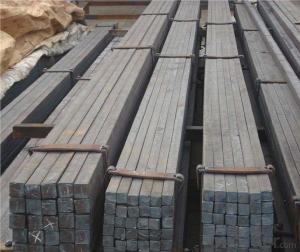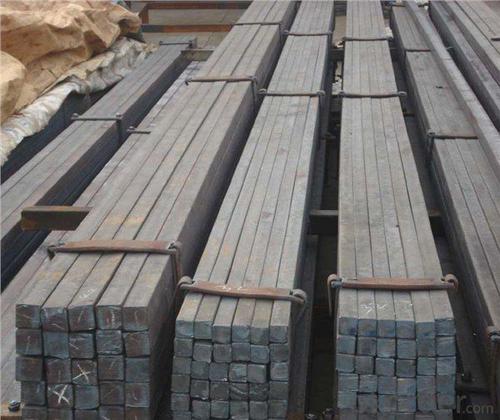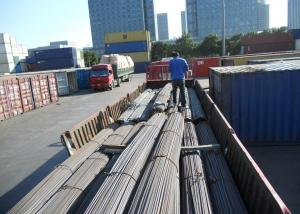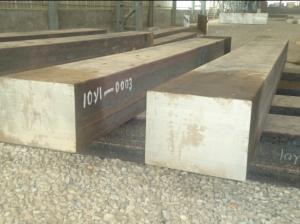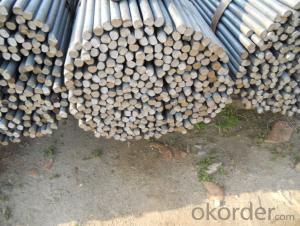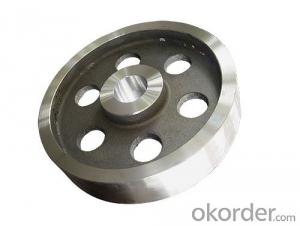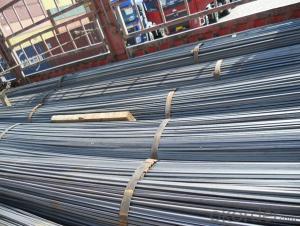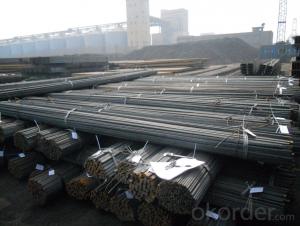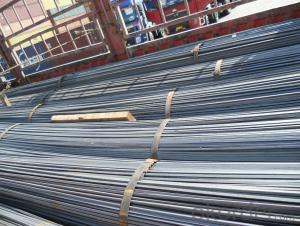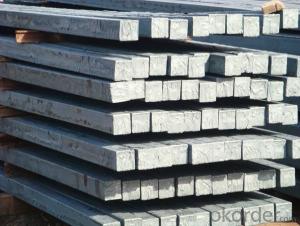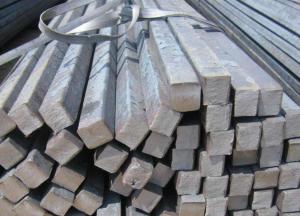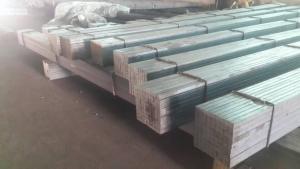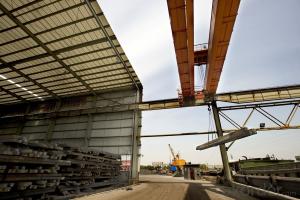Hot Rolled Square Bar with High Quality for Construction
- Loading Port:
- China main port
- Payment Terms:
- TT or LC
- Min Order Qty:
- 50 m.t.
- Supply Capability:
- 10000 m.t./month
OKorder Service Pledge
OKorder Financial Service
You Might Also Like
Product Description of Hot Rolled Square Bar with High Quality for Construction:
-Standard: GB,
-Grade: Q195 or equivalent.
-Chemical Composition:
Standard | Grade | Element (%) | ||||
GB | Q195 | C | Mn | S | P | Si |
0.06~0.12 | 0.25~0.50 | ≤0.050 | ≤0.045 | ≤0.30 | ||
Measures of HR Square Bar (small measures):

(Section of HR Square Bar)
-Length of a side and Theoretical weight of Square Bar.
Length of a side(mm) | Theoretical weight(kg/m) | Length of a side(mm) | Theoretical weight(kg/m) |
7 | 0.385 | 22 | 3.80 |
8 | 0.502 | 24 | 4.52 |
9 | 0.636 | 25 | 4.91 |
10 | 0.785 | 26 | 5.30 |
11 | 0.950 | 28 | 6.15 |
12 | 1.13 | 30 | 7.06 |
13 | 1.33 | 32 | 8.04 |
14 | 1.54 | 34 | 9.07 |
15 | 1.77 | 36 | 10.17 |
16 | 2.01 | 38 | 11.24 |
17 | 2.27 | 40 | 12.56 |
18 | 2.54 | 42 | 13.85 |
19 | 2.82 | 45 | 15.90 |
20 | 3.14 | 48 | 18.09 |
21 | 3.46 | 50 | 19.63 |
Notes:
1, The theoretical weights in the list, base on the density of 7.85 g/cm3.
2, Formula for theoretical weight of Square bar: (length of a side)2 * 0.00785
3, The numbers with *mean that they are not regular or we don’t offer them.
-Regular length of Square Bar:
Steel | Length of a side (mm) | Length of steel (m) |
Normal steel | < 25 | 4~10 |
> 25 | 3~9 | |
Steel of high quality | All measure | 2~6 |
Tool steel >75 | 1~6 |
Usage/Applications of Hot Rolled Square Bar with High Quality for Construction:
-The Square Bar is normally used as structure steel.
-Row material for other structure steel like steel angles, channels, I-beams, H-beams, etc…
Packaging & Delivery of Hot Rolled Square Bar with High Quality for Construction:
-Packing Detail: The products can be packed in bundles by steel wires.
-Marks: We make tag marks and color marks. The tag marks with white background and red company logo will be tied up to each bundle of the products. The information is usually including basic information of products and company and other information requested by customers. As for color marks, we will paint both ends of bundles to make sure that it will be more convenient for customers to distinguish them from other products.
-Delivery Detail: 30~45 working days after receive buyer’s T.T. or L/C.
Transportation of Hot Rolled Square Bar with High Quality for Construction:
-The products can be delivered by bulk vessel or by container. As for container, products with the length of 6m will be loaded in 20’ container, with 9m or 12m, in 40’ container.
-The maximum quantity of loading of container is 25 tons.
-The products are usually transported to the nearest port from the production place.
FAQ:
Q1: Why buy Materials & Equipment from OKorder.com?
A1: All products offered byOKorder.com are carefully selected from China's most reliable manufacturing enterprises. Through its ISO certifications, OKorder.com adheres to the highest standards and a commitment to supply chain safety and customer satisfaction.
Q2: How do we guarantee the quality of our products?
A2: We have established an advanced quality management system which conducts strict quality tests at every step, from raw materials to the final product. At the same time, we provide extensive follow-up service assurances as required.
Q3: How soon can we receive the product after purchase?
A3: Within three days of placing an order, we will begin production. The specific shipping date is dependent upon international and government factors, but is typically 7 to 10 workdays.
Images:
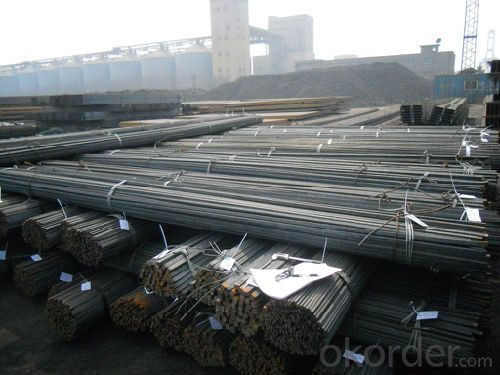
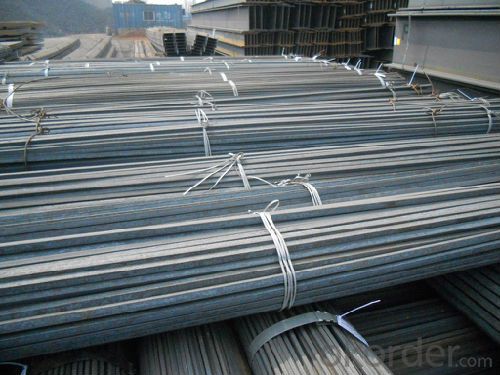
- Q: Can a steel square be used for stair layout?
- Stair layout can indeed be accomplished using a steel square. This multipurpose tool, also referred to as a framing square or carpenter's square, is commonly employed by builders and carpenters for various layout tasks, including stair layout. Comprised of two arms, with one being longer than the other and meeting at a 90-degree angle, a steel square offers versatility. The longer arm is typically equipped with measurements and markings that facilitate precise measuring and marking of stair components such as risers, tread lengths, and angles. By skillfully utilizing the diverse features and angles of a steel square, carpenters can effortlessly undertake the layout and construction of stairs with utmost precision and accuracy.
- Q: What are the different sizes of steel squares available?
- Steel squares come in various sizes to suit different applications and needs. Some of the common sizes include: 1. 2-inch steel square: This is a small-sized square primarily used for precision measurements and layout work in woodworking and metalworking. 2. 4-inch steel square: This is a medium-sized square that is commonly used for general layout work, marking right angles, and checking the squareness of components. 3. 6-inch steel square: This is a larger-sized square, often used in construction and carpentry for marking and measuring longer distances and larger components. 4. 12-inch steel square: This is a large-sized square typically used in construction and framing work. It is suitable for marking and measuring longer distances, checking squareness, and laying out larger components. 5. 24-inch steel square: This is an extra-large-sized square mainly used in construction and masonry work. It is ideal for marking and measuring longer distances, checking squareness, and laying out large-scale projects. Apart from these standard sizes, there are also specialty steel squares available in various lengths and widths, designed for specific purposes such as precision engineering, layout work in machining, and metal fabrication.
- Q: Can a steel square be used for measuring the height of a tower?
- No, a steel square cannot be used for measuring the height of a tower. A steel square, also known as a framing square, is a tool primarily used in carpentry and construction for measuring and marking right angles. It consists of a long metal blade with a perpendicular arm attached to it, forming an "L" shape. While it is useful for various tasks such as laying out stairs or checking corners for squareness, it is not designed for measuring vertical distances. To measure the height of a tower, specialized tools like a measuring tape, laser rangefinder, or a theodolite would be more appropriate. These tools are specifically designed to accurately measure distances and heights, making them more reliable for such applications.
- Q: How do you use a steel square to determine angles for picture frames?
- To use a steel square to determine angles for picture frames, you can start by placing the square against the corner of the frame. Then, align one edge of the square with the side of the frame. By reading the scale on the square, you can determine the angle at which the frame needs to be cut. This will help you achieve precise and accurate angles for your picture frames.
- Q: Can a steel square be used for checking the squareness of deck posts?
- Yes, a steel square can be used for checking the squareness of deck posts.
- Q: How do you use a steel square to lay out a parallelogram base?
- To use a steel square to lay out a parallelogram base, follow these steps: 1. Start by ensuring that your steel square is clean and free from any dirt or debris. This will ensure accurate measurements and markings. 2. Identify the desired dimensions for your parallelogram base. You will need to know the length and width of the base. 3. Use the longer side of the steel square, known as the blade, to measure and mark the length of the base on the material you are working with. Place the blade of the steel square against one edge of the material and extend it until it reaches the desired length. Make a light pencil mark at the end of the blade to indicate the length. 4. Next, rotate the steel square 90 degrees so that the shorter side, known as the tongue, is aligned with the pencil mark made in the previous step. Ensure that the blade is perpendicular to the material. 5. Extend the blade of the steel square until it reaches the desired width of the base. Make a light pencil mark at the end of the blade to indicate the width. 6. Now, remove the steel square from the material and connect the two pencil marks using a straightedge or ruler. This line represents one side of your parallelogram base. 7. Repeat steps 3 to 6 to create the opposite side of the parallelogram base. Ensure that the length and width measurements are consistent with the first side. 8. Finally, connect the two parallel sides of the base by drawing lines that are parallel to the width measurement. Use a straightedge or ruler to ensure accuracy. By following these steps, you can effectively use a steel square to lay out a parallelogram base with precise measurements and angles.
- Q: How do you use a steel square to determine the slope of a gutter?
- In order to determine the slope of a gutter using a steel square, the following steps should be followed: 1. Begin by measuring the width of the gutter using the outer edges of the steel square. Make sure that the square is firmly pressed against the gutter. 2. Proceed by positioning one side of the steel square against the bottom of the gutter, ensuring that it is level. The other side of the square should extend vertically towards the top edge of the gutter. 3. Verify that the steel square is perfectly vertical by using a level. If necessary, make adjustments. 4. Once the steel square is aligned correctly, examine the measurement markings on the square. The vertical side of the square indicates the rise or fall, while the horizontal side represents the run or distance. 5. Take note of the measurement where the horizontal side of the square intersects with the top edge of the gutter. This measurement will provide you with the rise or fall of the gutter. 6. To calculate the slope, divide the measurement of the rise or fall by the width of the gutter. This will yield the slope ratio, which can be expressed as a percentage or a ratio (e.g., 1:100). Utilizing a steel square to determine the slope of a gutter is an effective technique as it enables precise measurements and guarantees the proper installation of the gutter for efficient drainage.
- Q: How do you use a steel square to determine the angle of a roof truss?
- To use a steel square to determine the angle of a roof truss, you would need to follow these steps: 1. Start by placing the steel square against the edge of the truss where the angle needs to be measured. Make sure the square is aligned properly and securely against the truss. 2. Take note of the scale on the steel square. This scale usually consists of numbers and lines that represent degrees. The most common steel square has scales for measuring 90 degrees, 45 degrees, and 30 degrees. 3. Locate the line on the scale that corresponds to the desired angle you are trying to measure. For example, if you want to determine the angle of a truss that is 30 degrees, find the line on the scale that reads 30 degrees. 4. Next, align the line on the steel square that corresponds to the desired angle with the edge of the truss. This line should be parallel to the truss edge. 5. Once the line on the steel square is aligned with the truss edge, check the other side of the square. There should be another line or edge that intersects with the truss. This intersecting point will give you the angle measurement. 6. Read the angle measurement directly from the scale on the steel square at the intersecting point. This will give you the exact angle of the roof truss. Remember to ensure that the steel square is properly aligned and securely positioned against the truss to get accurate measurements. Additionally, it is essential to use the correct scale on the steel square that matches the desired angle you are trying to determine.
- Q: Can a steel square be used for stair railing layout and installation?
- Yes, a steel square can be used for stair railing layout and installation. A steel square, also known as a framing square or carpenter's square, is a versatile tool that is commonly used in carpentry and construction projects. It consists of a long arm and a shorter arm that meet at a 90-degree angle, forming a right triangle. When it comes to stair railing layout and installation, a steel square can be used to ensure accurate and precise measurements. It can be used to mark the angles and dimensions needed for cutting the railing components, such as balusters and handrails. The long arm of the steel square can be aligned with the edge of the stair tread or riser to accurately mark the locations for installing the railing posts. Furthermore, a steel square can be used to check for squareness and alignment during the installation process. It can be placed against the railing posts and used to verify that they are perpendicular to the stair treads and risers. This is crucial for ensuring a sturdy and level installation. In summary, a steel square is a valuable tool that can be used for stair railing layout and installation. Its versatility and accuracy make it ideal for marking angles, measuring dimensions, and checking for squareness during the installation process.
- Q: Can a steel square be used for cutting angles in woodworking?
- No, a steel square is primarily used for measuring right angles and marking straight lines in woodworking, but it is not designed for cutting angles.
Send your message to us
Hot Rolled Square Bar with High Quality for Construction
- Loading Port:
- China main port
- Payment Terms:
- TT or LC
- Min Order Qty:
- 50 m.t.
- Supply Capability:
- 10000 m.t./month
OKorder Service Pledge
OKorder Financial Service
Similar products
Hot products
Hot Searches
Related keywords
